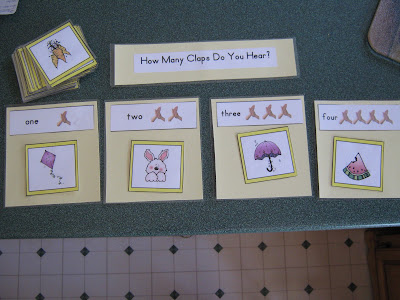Syllable Count
Curriculum Outcome: Early Literacy-
Phonological Awareness 2.2 Begins to segment and blend words into syllables
| <><>
Materials:
Game pieces
as shown in previous photo-
*Question card-How Many Claps Do You Hear?
*Small picture cards of items that children will use
to determine the amount of
claps/syllables (pictures will be of items that have either 1,2, 3, or 4
claps)
*Cards that are labelled 1 clap, 2 claps, 3 claps,
and 4 claps
*Clipboard
and sticky notes for assessment
| <><>
Description
of Activity: This game will be played in small groups of 4-5
children. Children will each take turns selecting a picture card and clap out
the syllables they hear. They will then place it on the corresponding number
card indicating the number of claps. Always use both words- claps and
syllables- interchangeably, so children will be aware of the language. Play
until all the game cards are placed.
| <><><><>
Assessment: As the Syllable Count game is played, the educator
may take anecdotal notes to record the child’s behaviors, questions,
strengths and challenges. The educator may also record scaffolding that
occurred or suggestions for the next time the game is played. Please see
suggestion for anecdotal note- taking in the photo below.
|
Reflection #1- Syllable Count
I chose this
activity knowing that the children in the class have had exposure to and
experience with counting syllables in their own names and the names of the
other children in the class. We had also taken the opportunity many times
throughout the school year to count syllables during shared and guided reading,
our morning message, and writer’s workshop.
This was the first time I had played this game with the
children. I really wanted them to feel successful, so I began the game with the
children sorting their own names by the number of syllables. I then moved on to
picture cards.
As I was preparing for this activity, I tried to consider
the many aspects I would need to ensure that I had communicated the directions
and expectations clearly to the children. I felt that for the most part, the
children understood what the game involved and they all felt, and were, in fact,
successful. Some of the children experienced difficulty with the one syllable
words. They tended to drag out a word to make it a two syllable word. I would
ask questions like, “do we say da-ad?” the children would say, “no” and would
re-do the clapping with only one syllable. This will be an area I will need to
re-visit with the children throughout the remainder of the school year.
The feedback that I offered the children was mostly verbal,
with some non-verbal communication occurring throughout the activity as well.
This seemed to work well for most of the students. I kept anecdotal notes as we
played this game and placed each child’s “sticky note” outlining their
participation in the game in the “Show Me What You Know” binder.
Easter was coming a
week down the road, so I decided to have the children place the picture cards
in Easter baskets, labelled with the numbers 1, 2, 3, and 4. This added to the
children’s enthusiasm and desire to have their small group visit this work
station. Overall, there was a high level of engagement for this hands-on,
fun activity.


No comments:
Post a Comment